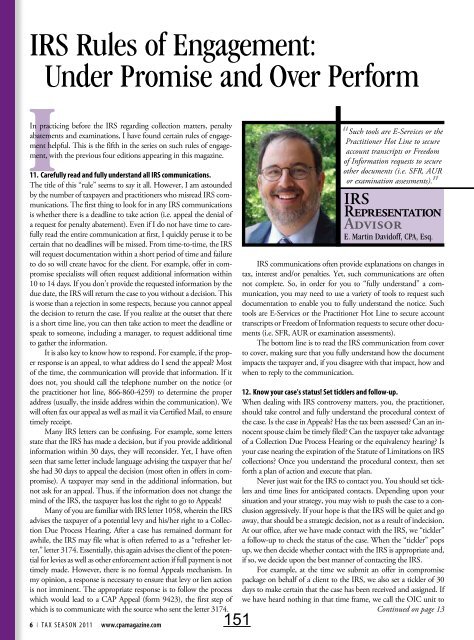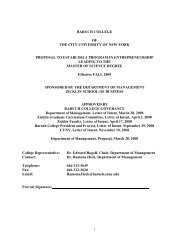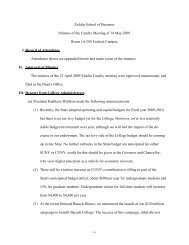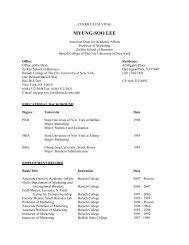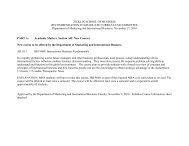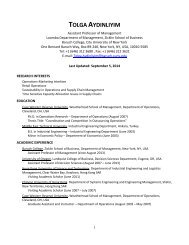Tax Seminar #3 – December 3 2012
Workbook - Zicklin School of Business
Workbook - Zicklin School of Business
You also want an ePaper? Increase the reach of your titles
YUMPU automatically turns print PDFs into web optimized ePapers that Google loves.
IRS Rules of Engagement:<br />
Under Promise and Over Perform<br />
IIn practicing before the IRS regarding collection matters, penalty<br />
abatements and examinations, I have found certain rules of engagement<br />
helpful. This is the fifth in the series on such rules of engagement,<br />
with the previous four editions appearing in this magazine.<br />
11. Carefully read and fully understand all IRS communications.<br />
The title of this “rule” seems to say it all. However, I am astounded<br />
by the number of taxpayers and practitioners who misread IRS communications.<br />
The first thing to look for in any IRS communications<br />
is whether there is a deadline to take action (i.e. appeal the denial of<br />
a request for penalty abatement). Even if I do not have time to carefully<br />
read the entire communication at first, I quickly peruse it to be<br />
certain that no deadlines will be missed. From time-to-time, the IRS<br />
will request documentation within a short period of time and failure<br />
to do so will create havoc for the client. For example, offer in compromise<br />
specialists will often request additional information within<br />
10 to 14 days. If you don’t provide the requested information by the<br />
due date, the IRS will return the case to you without a decision. This<br />
is worse than a rejection in some respects, because you cannot appeal<br />
the decision to return the case. If you realize at the outset that there<br />
is a short time line, you can then take action to meet the deadline or<br />
speak to someone, including a manager, to request additional time<br />
to gather the information.<br />
It is also key to know how to respond. For example, if the proper<br />
response is an appeal, to what address do I send the appeal? Most<br />
of the time, the communication will provide that information. If it<br />
does not, you should call the telephone number on the notice (or<br />
the practitioner hot line, 866-860-4259) to determine the proper<br />
address (usually, the inside address within the communication). We<br />
will often fax our appeal as well as mail it via Certified Mail, to ensure<br />
timely receipt.<br />
Many IRS letters can be confusing. For example, some letters<br />
state that the IRS has made a decision, but if you provide additional<br />
information within 30 days, they will reconsider. Yet, I have often<br />
seen that same letter include language advising the taxpayer that he/<br />
she had 30 days to appeal the decision (most often in offers in compromise).<br />
A taxpayer may send in the additional information, but<br />
not ask for an appeal. Thus, if the information does not change the<br />
mind of the IRS, the taxpayer has lost the right to go to Appeals!<br />
Many of you are familiar with IRS letter 1058, wherein the IRS<br />
advises the taxpayer of a potential levy and his/her right to a Collection<br />
Due Process Hearing. After a case has remained dormant for<br />
awhile, the IRS may file what is often referred to as a “refresher letter,”<br />
letter 3174. Essentially, this again advises the client of the potential<br />
for levies as well as other enforcement action if full payment is not<br />
timely made. However, there is no formal Appeals mechanism. In<br />
my opinion, a response is necessary to ensure that levy or lien action<br />
is not imminent. The appropriate response is to follow the process<br />
which would lead to a CAP Appeal (form 9423), the first step of<br />
which is to communicate with the source who sent the letter 3174.<br />
6 I TA X S E A S O N 2 0 11 www.cpamagazine.com<br />
151<br />
Such tools are E-Services or the<br />
“<br />
Practitioner Hot Line to secure<br />
account transcripts or Freedom<br />
of Information requests to secure<br />
other documents (i.e. SFR, AUR<br />
or examination assessments). ”<br />
IRS<br />
Representation<br />
Advisor<br />
E. Martin Davidoff, CPA, Esq.<br />
IRS communications often provide explanations on changes in<br />
tax, interest and/or penalties. Yet, such communications are often<br />
not complete. So, in order for you to “fully understand” a communication,<br />
you may need to use a variety of tools to request such<br />
documentation to enable you to fully understand the notice. Such<br />
tools are E-Services or the Practitioner Hot Line to secure account<br />
transcripts or Freedom of Information requests to secure other documents<br />
(i.e. SFR, AUR or examination assessments).<br />
The bottom line is to read the IRS communication from cover<br />
to cover, making sure that you fully understand how the document<br />
impacts the taxpayer and, if you disagree with that impact, how and<br />
when to reply to the communication.<br />
12. Know your case’s status! Set ticklers and follow-up.<br />
When dealing with IRS controversy matters, you, the practitioner,<br />
should take control and fully understand the procedural context of<br />
the case. Is the case in Appeals? Has the tax been assessed? Can an innocent<br />
spouse claim be timely filed? Can the taxpayer take advantage<br />
of a Collection Due Process Hearing or the equivalency hearing? Is<br />
your case nearing the expiration of the Statute of Limitations on IRS<br />
collections? Once you understand the procedural context, then set<br />
forth a plan of action and execute that plan.<br />
Never just wait for the IRS to contact you. You should set ticklers<br />
and time lines for anticipated contacts. Depending upon your<br />
situation and your strategy, you may wish to push the case to a conclusion<br />
aggressively. If your hope is that the IRS will be quiet and go<br />
away, that should be a strategic decision, not as a result of indecision.<br />
At our office, after we have made contact with the IRS, we “tickler”<br />
a follow-up to check the status of the case. When the “tickler” pops<br />
up, we then decide whether contact with the IRS is appropriate and,<br />
if so, we decide upon the best manner of contacting the IRS.<br />
For example, at the time we submit an offer in compromise<br />
package on behalf of a client to the IRS, we also set a tickler of 30<br />
days to make certain that the case has been received and assigned. If<br />
we have heard nothing in that time frame, we call the OIC unit to<br />
Continued on page 13


